Quads are all the rage nowadays — we blame the rise of shorter shorts, but hey, we aren’t complaining. If you’re here for quad-focused exercises, the best quad workouts, or the best movements for quad growth, rest assured you’ve come to the right place.
For everything from being able to squat a loaded barbell to developing a well-rounded musculature throughout your whole body, you need strong quads on your side: “Your quads are one of the most important muscles in your entire body. You use them to run, walk, jump, pick things up, and get through a leg day, of course,” says BarBend Senior Writer and personal trainer Jake Dickson.
Here are the best quad exercises for mass, strength, and everything else to get you closer to that tear-drop vibe..
Recent Updates: Senior Editor Alex Polish added three exercises and swapped a couple out in accordance with our exercise selection methodology, totaling 16 exercises. Other notable updates include adding movement modifications to each exercise and putting our best exercises together into workouts.
16 Best Quad Exercises
- Front Squat
- Heel-Elevated Back Squat
- Goblet Squat
- Bulgarian Split Squat
- Front-Foot-Elevated Dumbbell Split Squat
- Hack Squat
- Leg Press
- Low Cable Split Squat
- Sissy Squat
- Banded Sissy Squat
- Leg Extension
- Cyclist Squat
- Spanish Squat
- Step-Up
- Jump Squat
- Walking Lunge
Editor’s Note: The content on BarBend is meant to be informative in nature, but it should not be taken as medical advice. When starting a new training regimen and/or diet, it is always a good idea to consult a trusted medical professional. We are not a medical resource. The opinions and articles on this site are not intended for use as diagnosis, prevention, and/or treatment of health problems. They are not substitutes for consulting a qualified medical professional.
1. Front Squat
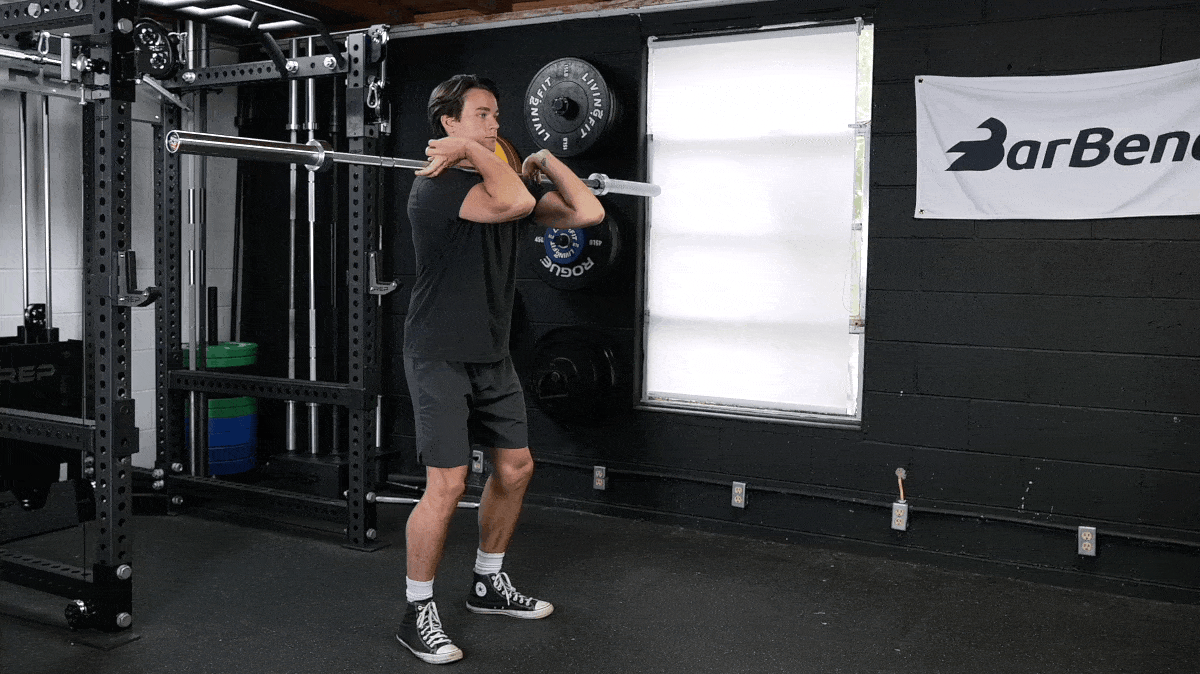
| Equipment Needed | Squat rack OR power rack; barbell, weight plates, barbell collars |
| Muscles Worked | Quads, upper back, erectors, abdominals |
| Sets & Reps | 3-4 sets of 4 to 10 reps |
To target your quads as directly as possible, try holding the barbell in front of you (on your shoulders) in a front squat. By loading the weight in front instead of behind you, you’ll be forced to keep your torso as upright as possible. In the front rack position, you’ll have to put a lot more pressure on your quads to maintain your balance and get that bar back up to standing. Your core will feel it, too (in the best way).
How to Do It
- Set up a barbell in a squat rack at roughly shoulder height.
- Step up to the bar, supporting it high on the fronts of your shoulders (delts) and potentially your upper chest. Bend your arms to tuck your fingers under the bar and keep your elbows pointing up. Maintain a tall posture and brace your core.
- Keep the barbell in that front-rack position and sink into your squat.
- After hitting the bottom of your squat, press back up to standing through your legs. Maintain a tall torso, core brace, and high elbows throughout.
Modifications
- Make it Easier: Perform a goblet squat (holding a dumbbell at chest height) instead of using a barbell if you have limited equipment or don’t have the wrist mobility needed to support a barbell front rack position.
- Make it Harder: Perform 1 ½ reps to increase your time under tension and seriously boost muscle-building potential.
2. Heel-Elevated Back Squat

| Equipment Needed | Squat rack OR power rack; barbell, weight plates, collars |
| Muscles Worked | Quads, glutes, hamstrings, calves, lower back, adductors, abductors |
| Sets & Reps | 3-4 sets of 8 to 10 reps |
The squat is a fundamental movement pattern that we engage in daily, such as when we squat down to pick something up or get in and out of a chair. By squatting with your heels elevated, you’re able to drive your knees further forward. This places more tension on your quads.
How To Do It
- Unrack a loaded barbell from a station or power rack, with the bar fixed securely on your traps. Walk backward a few steps.
- Place your heels on an elevated surface. This can be a heel wedge or two small weight plates. Ensure that your feet are about shoulder-width apart.
- Squat down with your chest up until the bottoms of your thighs are parallel to the floor, allowing your knees to travel forward freely.
- Drive back up by pushing your feet through the floor.
Modifications
- Make it Easier: Instead of using a barbell, elevate your heels during a bodyweight squat. To add load, use a kettlebell or dumbbell for a heels-elevated goblet squat.
- Make it Harder: Perform this move with a slow tempo to spend more time under tension.
3. Goblet Squat

| Equipment Needed | Dumbbell OR kettlebell |
| Muscles Worked | Quads, glutes, hamstrings, adductors, upper back, core |
| Sets & Reps | 3-4 sets of 8 to 15 reps. |
A fabulous exercise for beginners and advanced athletes alike, the goblet squat is a classic staple of leg day for a reason. You’ll hold a dumbbell or kettlebell at chest height, but you don’t need nearly as much wrist and shoulder mobility as you do with barbell front squats. The goblet squat places a ton of emphasis on your quads.
How To Do It
- Lift a kettlebell or dumbbell with both hands, holding it with your thumbs resting against your upper chest.
- Maintain an upright posture, keeping your shoulders back and down. Brace your core.
- Squat down until your thighs break parallel with the floor.
- Push through your feet to return to standing.
Modifications
- Make it Easier: Hold your hands at your chest without weight to simulate the upright position of a goblet squat while still practicing with your body weight. Place a weight bench slightly behind you so that you can have a guidepost to sit on gently during your sets.
- Make it Harder: Pause your squat in the bottom position while maintaining tension in your core, upper back, and quads.
4. Bulgarian Split Squat
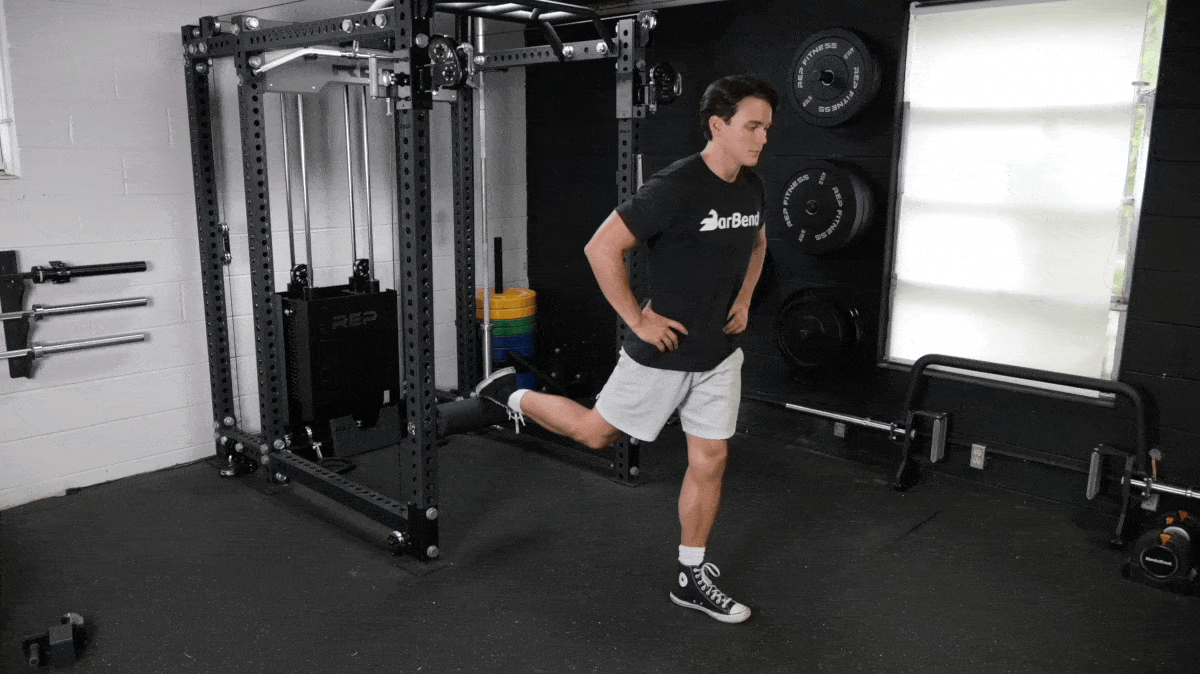
| Equipment Needed | Weight bench OR plyo box; dumbbells |
| Muscles Worked | Quads, glutes, hamstrings, calves, adductors |
| Sets & Reps | 2-4 sets of 8 to 12 reps per side. |
There’s a reason so many lifters dread the Bulgarian split squat: it’s tough. The Bulgarian split squat will strengthen your legs very effectively, as your back leg will be elevated on a weight bench or plyo box. It’ll likely also present a strong mental challenge to build the fortitude and discipline you need to power through even the trickiest of the squat accessory exercises.
How To Do It
- Stand a few feet in front of a plyo box or weight bench. Adjust your position so that as you place your back foot laces down on the elevated surface, both of your knees can reach 90 degrees when bent.
- Grab hold of a free weight (if you’re using one) and stabilize your position. Brace your core and sink into a lunge.
- Descend until your back leg reaches its full range of motion — your back knee should be pointing down at the ground.
- Press hard into your front foot to rise back to standing.
Modifications
- Make it Easier: Perform this movement without weight to start. If elevating your back foot is too intense of a strength or balance challenge, just do split squats on even ground. Set yourself up in a shortened lunge position, but keep your feet still as you complete all your reps on one side before switching positions and doing all your reps on the other side.
- Make it Harder: Do 1 ½ reps to ensure that you’re maximizing your muscle growth potential by increasing your time under tension, including when performing leg workouts with dumbbells.
5. Front-Foot-Elevated Dumbbell Split Squat
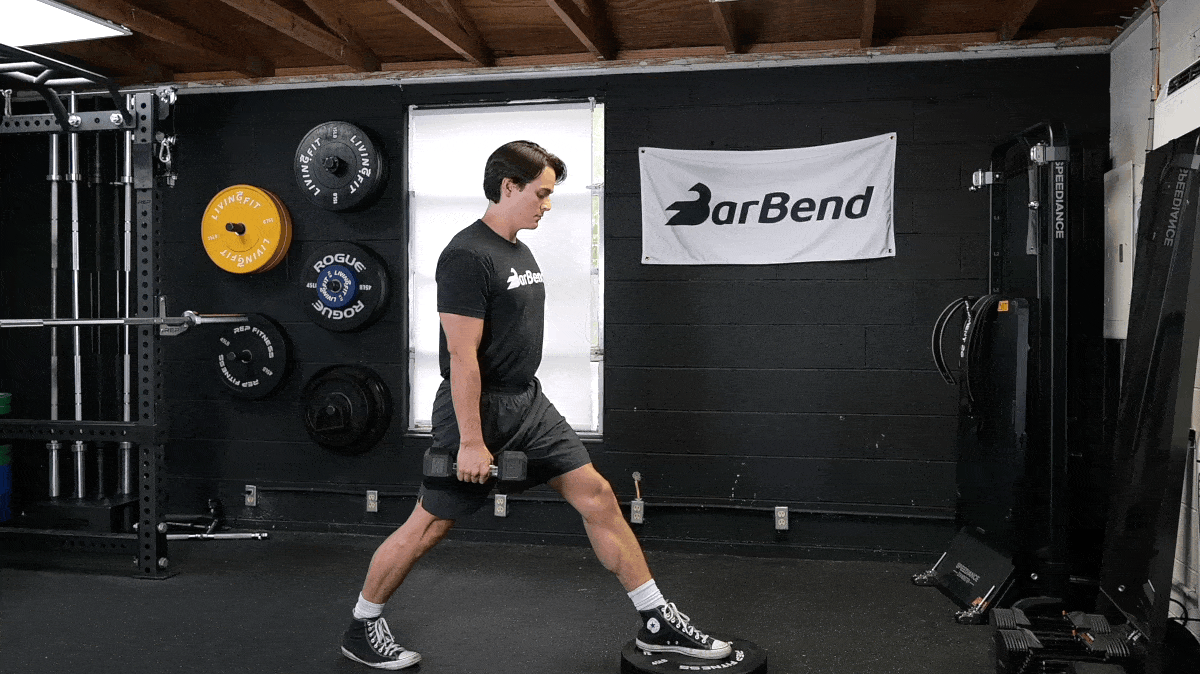
| Equipment Needed | Weight bench OR plyo box; dumbbells |
| Muscles Worked | Quads, glutes, hamstrings |
| Sets & Reps | 3-4 sets of 4 to 10 reps |
[Read More: Make the Most Out Of Leg Day With the Best Leg Exercises for Mass]
This squat variation isolates one quad at a time, which also allows you to target a potentially lagging quadricep on one side. The heel lift allows you to drive your working knee forward further, placing more muscular tension on the quads. Like other leg exercises, this variation can be loaded for more muscular tension. By loading up heavily, you can increase your muscle hypertrophy and strength potential, making it one of the best quad exercises for mass.
How To Do It
- Stand with a dumbbell in each hand.
- Take a step forward, placing your front leg heel onto an elevation.
- Keep your chest up and squat down until the knee of your back leg is about an inch above the floor.
- Stand back up by driving your front foot through the floor.
Modifications
- Make it Easier: As with the Bulgarian split squats, do this with just your body weight to start. You can also simply perform split squats on even ground.
- Make it Harder: Do this movement with a 1 ½ rep scheme to maximize time under tension.
6. Hack Squat
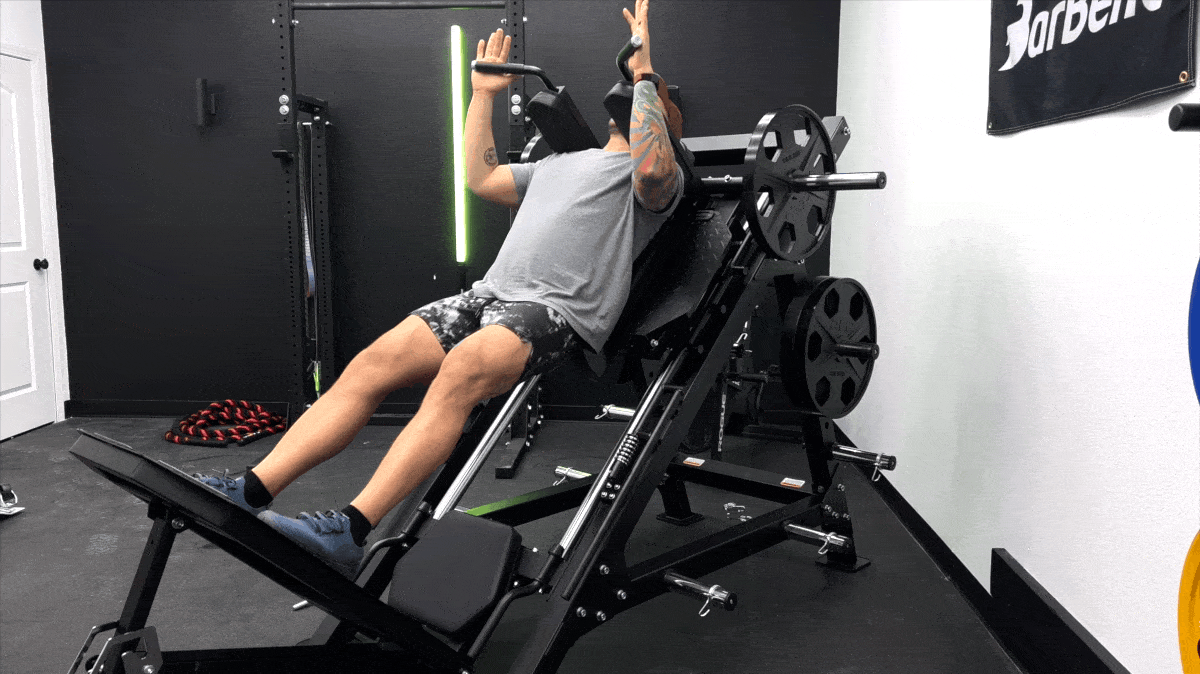
| Equipment Needed | Hack squat machine OR barbell, weight plates, collars |
| Muscles Worked | Quads, glutes, hamstrings, calves, core |
| Sets & Reps | 3-4 sets of 6 to 8 reps |
Originally the beloved brainchild of George Hackenschmidt, this exercise reinforces your squat movement pattern by using a machine to help you out. The machine creates external stability, removing the need to balance during each rep. When you don’t have to worry about balance, you can load up the weight pretty significantly.
How To Do It
- Your stance on the foot platform will closely mimic that of your back squat stance. As such, your torso should be stable with your abdominals engaged and your lower back flat on the back pad.
- Maintain a neutral head position as you lower your body until the bottoms of your thighs are parallel to the foot platform.
- Drive through your heels to return to the top position.
Modifications
- Make it Easier: No machine? That’s okay. You can set up the barbell behind you on a platform and proceed from there with an overhand grip, squatting with the bar behind you.
- Make it Harder: Pause briefly in the bottom position, maintaining full body tension, before coming back to standing with each rep.
7. Leg Press
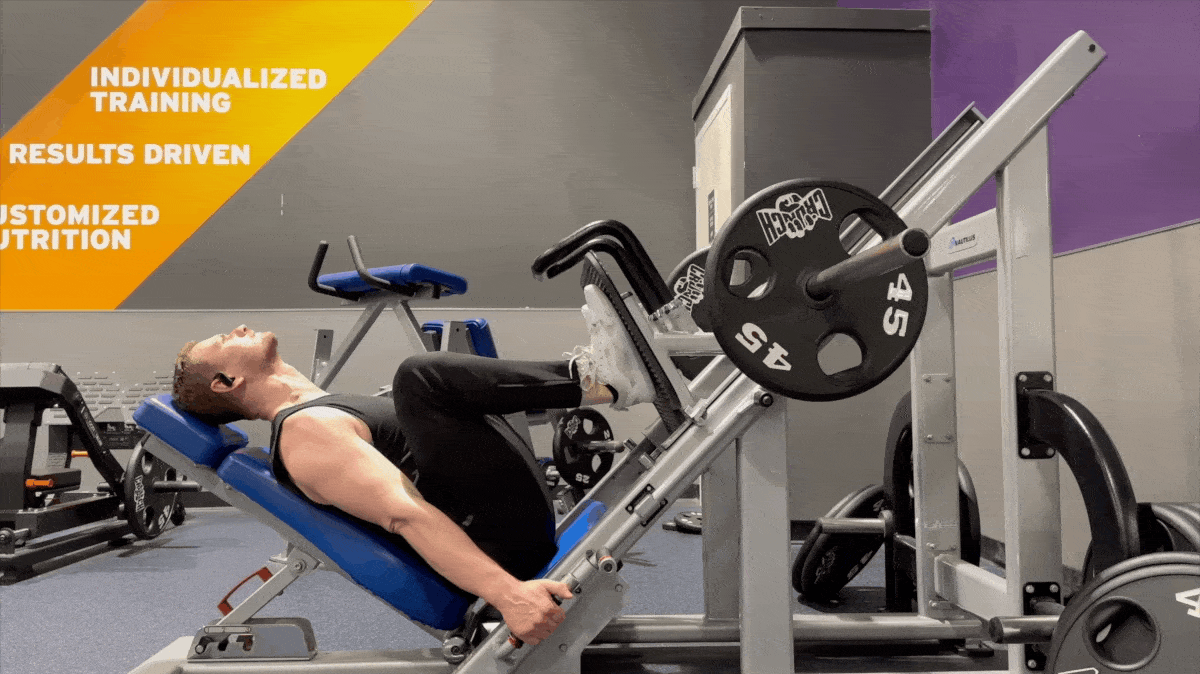
| Equipment Needed | Leg press machine, weight plates |
| Muscles Worked | Quads, glutes, hamstrings, calves |
| Sets & Reps | 3-4 sets of 8 to 12 reps |
The leg press is another fantastic exercise for building strong resilient quads. Changes to foot position, adjustments to back pad angle, and built-in safety mechanisms help make the leg press a reliable, customizable option for quad training.
You can also train your quads with incredibly heavy loads, as this outer quad exercise lets you load up. Make sure you’re keeping your hamstring and glute training intense, too — you don’t want to overuse this move and get disproportionate strong on only one part of your lower body.
How To Do It
- Place your feet on the sled of a leg press machine, matching your standard squat stance if possible.
- Press the sled out of the rack and lower the safety bars.
- Lower the sled toward your chest with control until your thighs break 90 degrees.
- Press the sled back up. Do not lock out your knees fully at the top of the movement.
Modifications
- Make it Easier: Placing your feet a bit lower on the sled will bias your quads; a bit higher will place a little more emphasis on your glutes and hamstrings.
- Make it Harder: Place your feet closer together on the sled to bias your outer thighs a bit more; and slightly farther apart to target more of your inner thighs.
8. Low Cable Split Squat

| Equipment Needed | Cable machine, D-handle |
| Muscles Worked | Quads, upper back, erectors, abdominals |
| Sets & Reps | 3 sets of 15 to 20 reps per side |
[Read More: The Best Cable Leg Workouts to Build Lower Body Muscle and Strength]
This cable-based squat variation is another great exercise for training one leg at a time. The directional pull from the cable not only guides your path but also acts as a natural cue to drive the knee further forward — placing more tension on the quads. These are great for beginners who need a more stationary bodybuilding leg workout and for more advanced trainees who want to place targeted emphasis on the quads.
How To Do It
- Set the cable attachment on the lowest peg and grasp the handle with the hand opposite your working leg.
- Take a step back and extend the non-working leg (the same side leg that is holding the handle) back to position yourself into a staggered stance.
- Drive your knee forward as far as possible.
- Extend your knee and return to the starting position.
Modifications
- Make it Easier: Extend your free hand for balance to make sure you can stay as stable as possible during movement.
- Make it Harder: Transform this move into a front-foot elevated split squat if you need even more tension by adding a bench, low plyo box, or step up platform to the mix.
9. Sissy Squat
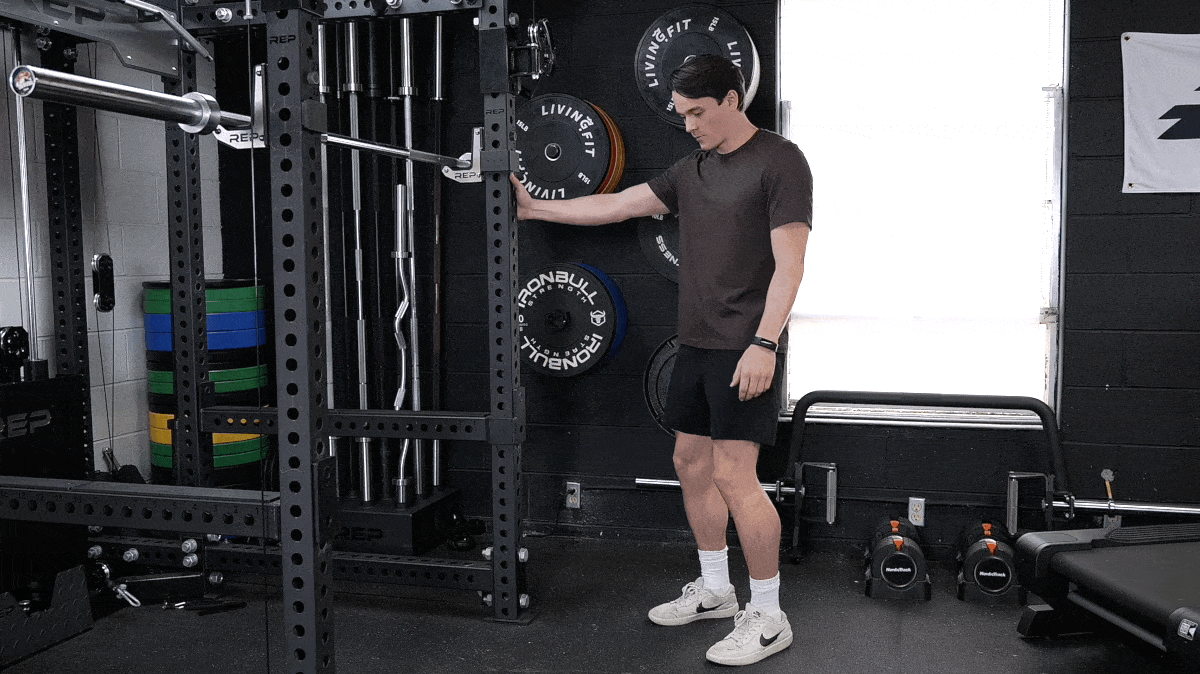
| Equipment Needed | Bodyweight-only OR squat rack or PVC pipe for balance |
| Muscles Worked | Quads, core |
| Sets & Reps | 3-4 sets of as many reps as possible (with good form) |
This movement is a powerful quad builder. For the most part, you’ll be taking your hips out of the equation of a squat and directly loading all the tension onto your knee extensors — your quads. You’ll also gain a lot of balance practice, not to mention motor control, proprioception, and confidence.
How To Do It
- Stand upright with your feet under your hips. Drive your knees forward and lean back slowly.
- Release your heels from the ground and continue descending.
- Once you’ve dipped as low as you can and pause to stabilize.
- Reverse the motion and return to standing.
Modifications
- Make it Easier: Use a PVC pipe or hold onto a stable surface (like a squat rack) to support your balance, especially as you’re learning this movement.
- Make it Harder: Wear a light weight vest during this exercise to progress it.
10. Banded Sissy Squat
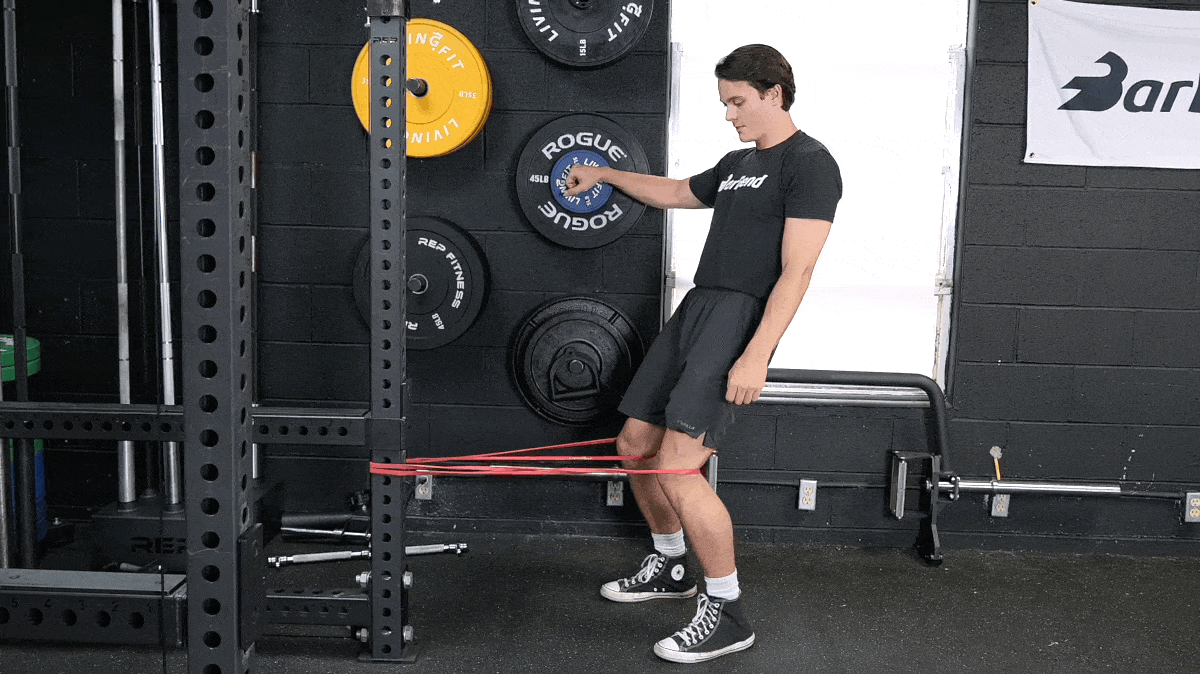
| Equipment Needed | Power rack, resistance band |
| Muscles Worked | Quads, core |
| Sets & Reps | 3-4 sets of 10 to 15 reps |
Sure, the banded sissy squat is technically a variation of the sissy squat. But since you’ll be adding resistance in such a unique fashion, we decided that this one deserves its own slot. The banded sissy squat keeps all the benefits of the conventional sissy squat but adds resistance from the mid-point to the top, where this exercise typically loses most of its challenge.
How To Do It
- Anchor a band to a power rack and around your legs (behind the knees).
- Take two or three steps back and lean your torso forward at your hips.
- Place your hands on the power rack in front of you.
- Drive your knees forward until they are fully flexed. Allow your heels to come off the ground.
- From the bottom, extend your knees hard against the resistance of the band.
Modifications
- Make it Easier: Perform the bodyweight version of this move while holding a pair of anchored TRX straps. That way, the TRX system can support some of your weight (and balance) while you learn the movement.
- Make it Harder: Perform this move while wearing a light weighted vest.
11. Leg Extension
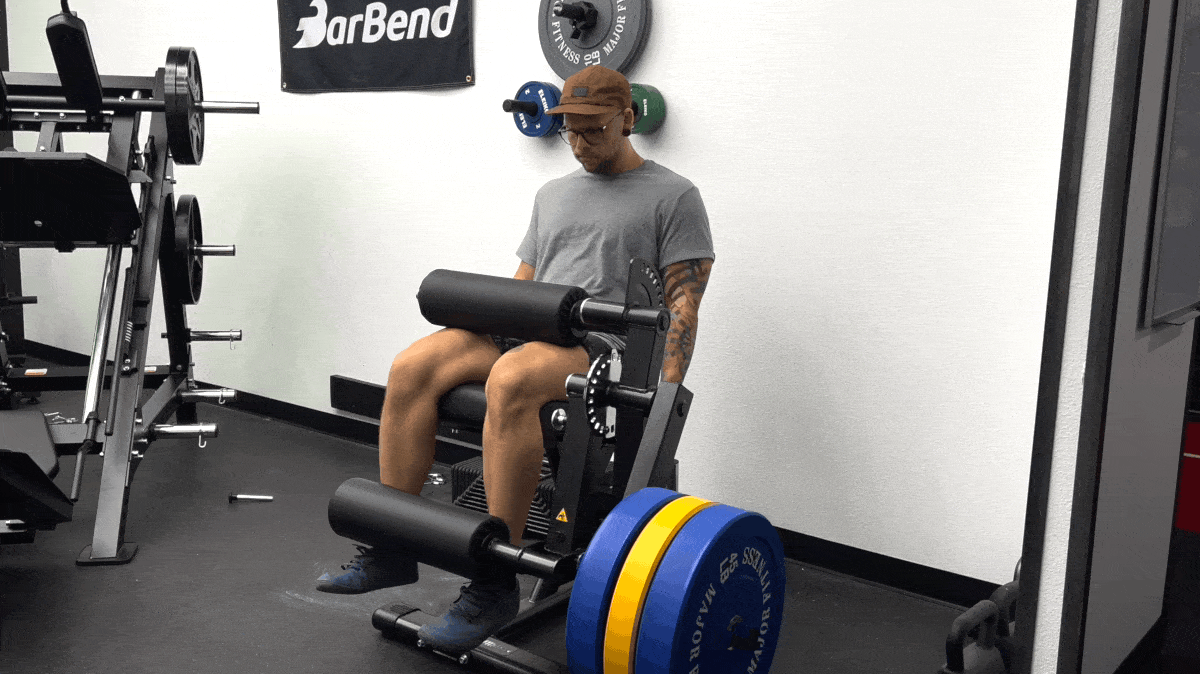
| Equipment Needed | Leg extension machine |
| Muscles Worked | Quads |
| Sets & Reps | 2-3 sets of 12 to 20 reps |
When performed with control and proper form, the leg extension is a stellar exercise to hone in on your quads. It’s easy to learn and execute (there’s practically no learning curve) and it doesn’t load your spine. That’s great news for lifters who want to target their legs without involving their back.
“Add a Pad or rolled-up yoga mat to the pad on the leg extension to add a deeper range of motion,” Masi advises. “You can also set the seat further back so you can lean back slightly to put a further stretch on the quads.”
How To Do It
- Adjust the back pad on the machine such that the backs of your knee fit snugly against the edge of the seat.
- Extend your knees to move the ankle pad, until your knees are fully straightened.
- Lower the weight back down with control.
Modifications
- Make it Easier: Perform bodyweight leg extensions in a chair if you don’t have access to the machine. Squeeze your quads hard at the top of each rep.
- Make it Harder: Perform the eccentric (lowering) portion of each rep as slowly as you can.
12. Cyclist Squat
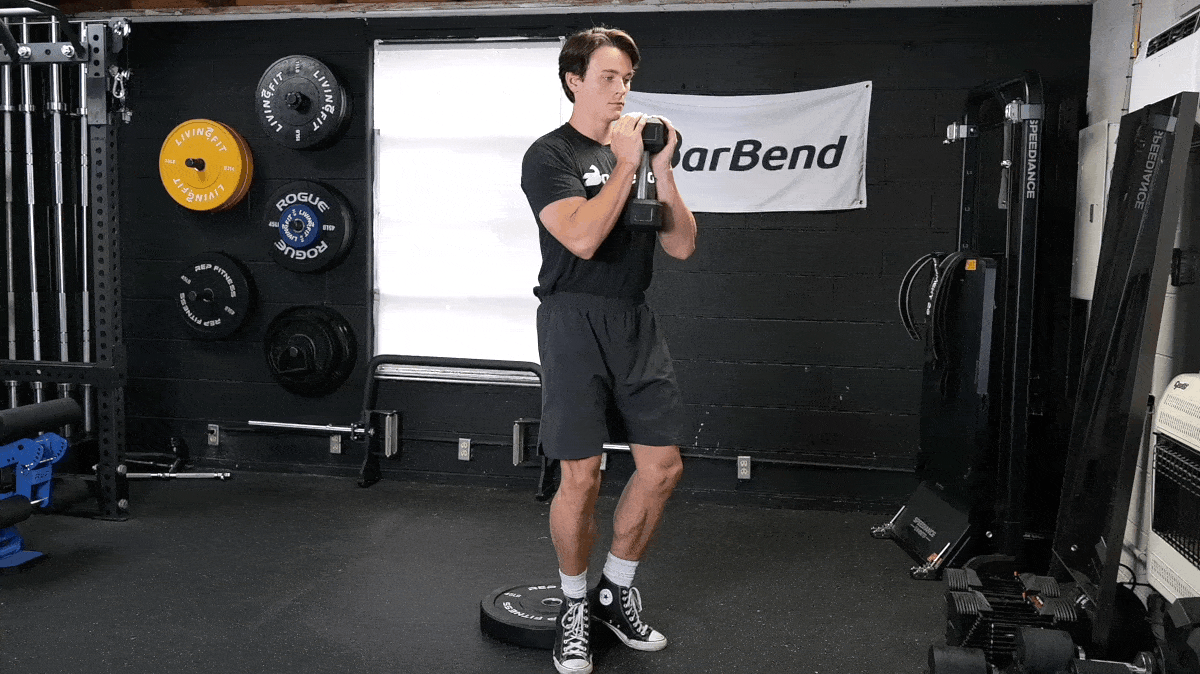
| Equipment Needed | Barbell OR dumbbells; weight plate |
| Muscles Worked | Quads, glutes, hamstrings |
| Sets & Reps | 3-4 sets of eight to 12 reps |
Competitive cyclists are known for their monstrous quads, and it’s no wonder why — their sport involves thousands of reps of knee extension. The cyclist squat mimics the posture you’d take on a bicycle while giving an unmatched challenge to the knee extensors.
How To Do It
- With a barbell on your back or a pair of dumbbells in each hand, place your feet very close together while your heels are significantly elevated — up to two inches.
- Brace your core and slowly squat down, allowing your knees to travel well beyond your toes until your hamstrings make contact with your calves.
- Return to the starting position by contracting the quads only, maintaining a still posture in your torso and hips.
Modifications
- Make it Easier: Perform narrow-stance goblet squats with your heels elevated. If you can’t load this up right away, just practice with your body weight.
- Make it Harder: Do this move while wearing a weighted vest.
13. Spanish Squat

| Equipment Needed | Squat rack, resistance band |
| Muscles Worked | Quads, glutes, hamstrings, core |
| Sets & Reps | 3-4 sets of as many reps as possible (with good form) |
The Spanish squat doesn’t require weight to bring the heat to your quads. All you need is a resistance band and a sturdy anchor for it, like a power rack or squat rack. The pull of the band around your knees will keep you upright while you squat as deep as you can. This trains both squatting confidence and an even more solid quad activation.
How To Do It
- Secure a heavy resistance band around a stable anchor, like a squat rack. Stand inside the other end of the band, setting it so that the band is right below the crease of your knees.
- Take a few steps back until the band is taut. Adjust to make sure that your feet are about hip-width apart.
- Squat down until your thighs are parallel to the ground. Pause and stand back to starting position.
Modifications
- Make it Easier: Use a PVC pipe to help you keep your balance during this movement.
- Make it Harder: Wear a weighted vest or hold a dumbbell in the goblet squat position to up the challenge.
14. Step-Up

| Equipment Needed | Step-up platform OR plyo box |
| Muscles Worked | Quads, glutes, core |
| Sets & Reps | 3-4 sets of 8 to 15 reps per side |
The step-up is another tremendous quad builder that doesn’t require a lot of weight to pack a punch. You’ll be using your own body weight to drive your gains here — unless you choose to add dumbbells or a loaded barbell to the mix. Your hip mobility will also stand to improve here, especially if you choose a higher platform or box to step up to.
How To Do It
- Stand in front of a stable, elevated surface like a plyo box or a step-up platform.
- Raise your working leg and plant it firmly on the box or platform in front of you. Shift most of your weight onto that foot. Brace your core.
- Drive down with your working leg, lifting your body upward. Squeeze your quads, stepping until your knee and hip lock out.
- Stabilize, then step back down. Repeat for reps, keeping it even on both sides.
Modifications
- Make it Easier: Use a step that’s no higher than your mid-shin to start.
- Make it Harder: Upgrade your box or platform to one that is at the level of your knee or even higher.
15. Jump Squat
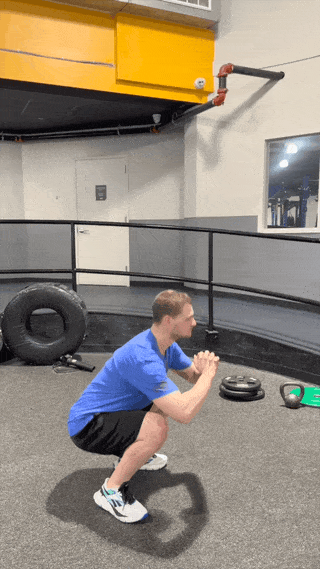
| Equipment Needed | Bodyweight-only |
| Muscles Worked | Quads, hamstrings, glutes, calves |
| Sets & Reps | 4-5 sets of 5 to 15 reps |
This isn’t your average bodyweight squat. Instead, you’ll be taking things to a plyometric level. The jump squat will have your quads train not just to be strong, but to be powerful. By adding an explosive element to your training, you’ll increase the muscle-building potential and cardiovascular involvement of one of the best bodyweight exercises.
How To Do It
- Stand with your feet a little wider than shoulder-width apart. (This will vary depending on your body shape and limb length. Experiment with a few soft hops to see what works best for you.)
- Sink into a partial squat with your thighs a little bit above parallel. Build tension in your quads and glutes.
- Once you’ve reached the bottom position, explode by driving into the ground. As your feet leave the ground, draw your arms in front of your body to continue driving your momentum vertically.
Modifications
- Make it Easier: Learn to control your depth and momentum by performing a seated rocker jump. Simply set up a box at about hip height, and explosively jump up before landing and resetting on the box.
- Make it Harder: Add some light resistance by hugging a medicine ball in front of your chest. A 10 or 20-pound ball (depending on your working time) should do the trick.
16. Walking Lunge

| Equipment Needed | Bodyweight-only |
| Muscles Worked | Quads, glutes |
| Sets & Reps | 3-4 sets of eight to 15 reps per side |
The walking lunge is a classic for a reason. This movement doesn’t require any external load — though you certainly can carry a load in a wide variety of ways, from overhead barbell lunges to walking lunges holding dumbbells at your sides. However you do them, walking lunges will carve you some powerful quads and glutes. And that’s not to mention a hefty sense of determination and hip mobility.
How To Do It
- Stand in front of an open walking path, standing tall with your feet hip-width apart and with a stacked torso.
- Take a medium to long stride forward, stepping in a straight line with full foot pressure. Control your descent, lowering until your working leg reaches about 90 degrees.
- Stride forward, alternating legs as you go.
Modifications
- Make it Easier: Return both feet to starting position between each rep so that you can reset your balance. You can also tap with your alternating foot as a simple touchpoint.
- Make it Harder: Flow directly from one lunge into the next. You can also hold weights during this move to add external load.
Sample Quad Workouts
Lifters at all levels are looking for something different from quad exercises. You might be chasing that tear-drop aesthetic, or you might be primarily concerned with boosting your overall strength. Or, you might be planning your workouts around equipment availability (or lack thereof). That’s where we come in — we’ve got a quad workout for every goal.
Quad Warm-Up
A dynamic warm-up for any muscle group is also going to incorporate the exercises you are performing in that day’s training session. For example, if you’re performing heel-elevated back squats, you can warm up by performing light reps and increasing the intensity as you proceed toward your working sets. This ensures that the appropriate muscles and joints are being primed, reducing the risk of injury and improving your overall training performance.
Work the following moves into your full-body warm-up when leg day rolls around. Your lifts will be glad you did.
- Walking Quad Stretch: 1 x 15 per side
- Bulgarian Split Squat Pulse: 1 x 15 per side
- Exercise-Specific Ramp-Up Set: 1-3 x 4-6
Quad Workout for Beginners
Training unilaterally and with reasonable loads to perfect technique is the best way to succeed when training the quads as a beginner. This means choosing variations of exercises that challenge your motor control in a safe way. Developing solid bodily control can help with your performance of more skill-heavy movements down the line, so there’s no reason to skimp out on the basics.
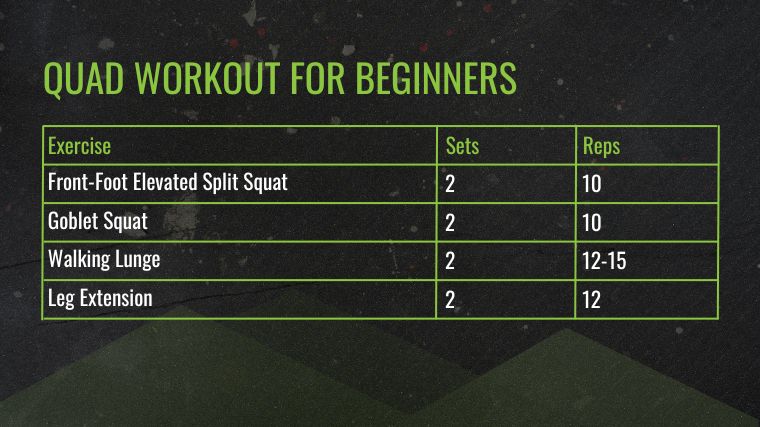
- Front-Foot Elevated Split Squat: 2 x 10
- Goblet Squat: 2 x 10
- Walking Lunge: 2 x 12-15
- Leg Extension: 2 x 12
Equipment Needed: Plyo box OR weight bench; dumbbells; leg extension machine
Quad Workout for Hypertrophy
To maximize hypertrophy, you should prioritize as much tension on the quads as possible without risking loss of position or potential injury. In practical terms, this can mean swapping out complex exercises like the full barbell squat for something like the leg press. The best exercises for quad growth also demands more total volume by jacking up your sets and reps and selecting weights that are properly challenging.

- Leg Press: 4 x 8-12
- Barbell Bulgarian Split Squat: 4 x 10-12
- Leg Extension: 4 x 10-12
Equipment Needed: Leg press machine; weight bench OR plyo box; dumbbells; leg extension machine
[Read More: The Best Hypertrophy Leg Workout (+Tips and Tricks)]
Quad Workout for Strength
Any competitive powerlifter can tell you how important strong quads are — for more than just squatting heavy. The leg press is a solid choice here, since you can load your legs up heavily even if your core or back is fatigued. A bit of light to moderate front squatting under fatigue will push your strength levels even further.
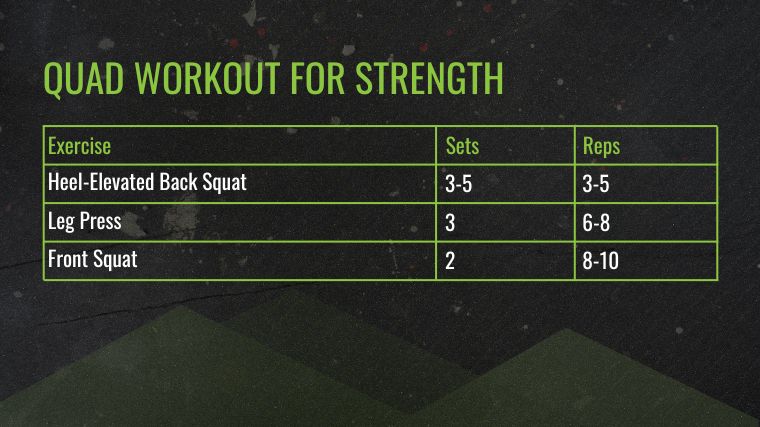
- Heel-Elevated Back Squat: 3-5 x 3-5
- Leg Press: 3 x 6-8
- Front Squat: 2 x 8-10
Equipment Needed: Squat stand OR power rack; barbell; weight plates; collars; leg press machine; weight bench OR plyo box; dumbbells
Bodyweight Quad Workout
Believe it or not, you can still get a bodyweight leg workout without access to a barbell or even a home gym. When an external load is out of the question, looking towards explosiveness and extended ranges of motion can help induce growth and cook the quads — without loading up on plates. Start with explosive, unilateral exercises as they are the most technically challenging and demand the most coordination.
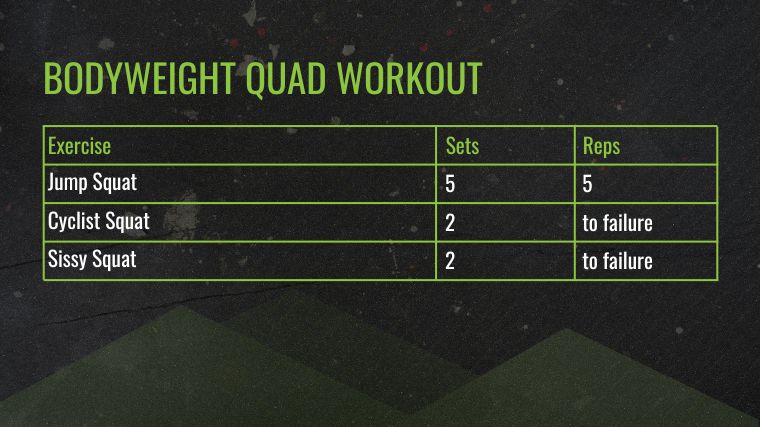
- Jump Squat: 5 x 5
- Cyclist Squat: 2 sets to failure
- Sissy Squat: 2 sets to failure
Equipment Needed: Bodyweight-only
Quad Workout for Endurance
To test and train endurance, selecting movements that let you safely push your limits is the name of the game. Machine work, cranking up the reps, and reducing rest times are all high priorities here.
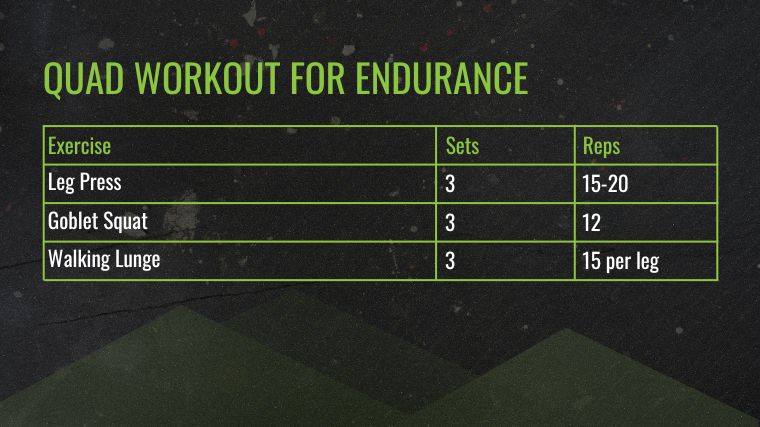
- Leg Press: 3 x 15-20
- Goblet Squat: 3 x 12
- Walking Lunge: 3 x 15 repetitions per leg
Equipment Needed: Leg press machine; dumbbell
What Muscles Make Up the Quadriceps?
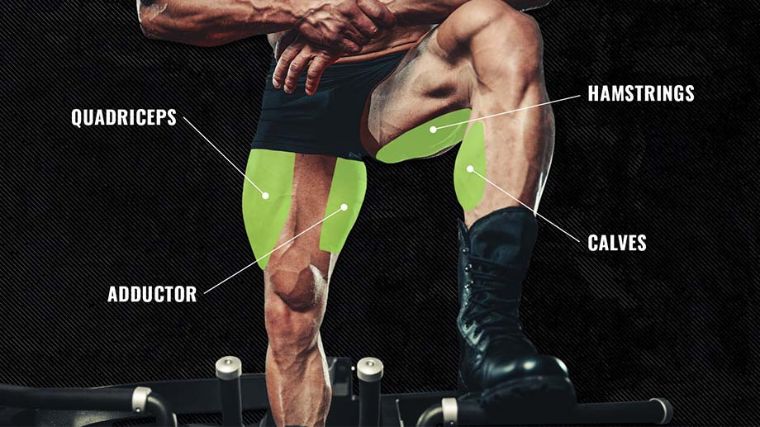
The quadriceps are made up of four distinct muscles, namely:
- Rectus Femoris
- Vastus Lateralis
- Vastus Medialis
- Vastus Intermedius
These muscles make up the bulk of the front of the thigh, help stabilize the knee, and play a vital role in hip stability.
The quadriceps all perform the same primary function of knee extension. The rectus femoris also helps stabilize you. In movements like a farmer’s carry, the quadriceps work double-time to help stabilize the hips. (1)
- Three of your four quad muscles cross only the knee joint, and thus do not perform any other action besides knee extension.
- Your rectus femoris crosses the knee and hip joints, which means it can assist with both knee and hip extension.
- To isolate your rectus femoris, you should find quad exercises for mass that you can do with an extended hip, such as the sissy squat or sitting back as far as possible on the leg extension station.
Benefits of Training Your Quads
Training your quads specifically not only helps build more functional strength — aiding in exercises like the squat and deadlift — but packs on size to your legs in a big way. If you’re looking to size up your khakis, kicking your quad training up a notch is a surefire way to be bursting at the seams.
You’ll Improve Your Bigger Lifts
Building up muscle and strength in the front of your legs leads to an increase in performance across the board. Stronger quads can lead to increased performance on your squat, deadlift, lunges, sled variations, and more.
[Read More: The Best Knee Sleeves You Can Buy On The Market]
Alongside noticeable gains in strength, training the quads more directly will pack on noticeable size to your legs — commanding respect and turning heads.
More Potential Resilience Against Injury
Your quads play a vital role in helping stabilize the knee during many motions, including squats, deadlifts, power cleans, walking, sprinting, and jumping. Since the knee joint is one of the largest and most active in the human body, it deserves every ounce of attention we can give it.
[Read More: Best Foam Roller Exercises For the Quads]
Your quad muscles muscles work together alongside your hamstrings and calves to protect your knees. This protection can allow you to lift, move, and remain independent as you age.
Quad Training Can Keep You Moving
Your walking speed is a vital metric in healthy aging. A large body of scientific literature points us to the relationship between gait speed, our ability to get up out of a chair, and preventing falls or other age-related accidents. (2)
Further, any time you get up and down from a chair, you’re squatting. Walking up or down the stairs is essentially a lunge. Building strong and resilient quads can help you engage in daily life while also keeping you more independent as you age.
Frequently Asked Questions
Training your quads isn’t just important for aesthetics — strong quads are a cornerstone of a strong body. Here, we’ll wrap up any lingering questions you’ve got about the best quad exercises out there.
How many quad exercises should you do per workout?
If you’re including quad or thigh exercises or thigh workouts, you should include between two and three individual exercises per workout, including at least one compound exercise and one isolation move.
What exercises build quads fast?
Of all quad-focused exercises you can do during your quadriceps workouts, none get the job done better than squats. You should also go for a single-leg squatting exercise for quads like the split squat or step-up, and include some machine isolation on the leg extension as well.
How many times per week should I train quads?
Like any muscle, the best exercises for quad growth will require adequate recovery. Shoot for two or three quad-focused exercises per workout, and roughly two workouts per week.
What are good quad exercises to do at home?
When it comes to bodyweight quad exercises without weights, we recommend cyclist squats, lunges, or high step-ups.
References
- Bordoni B, Varacallo M. Anatomy, Bony Pelvis and Lower Limb, Thigh Quadriceps Muscle. [Updated 2021 Feb 7]. StatPearls Publishing; 2021.
- Stephan, Y., Sutin, A. R., & Terracciano, A. (2015). “Feeling younger, walking faster”: subjective age and walking speed in older adults. Age (Dordrecht, Netherlands), 37(5), 86.
Featured Image: GaudiLab / Shutterstock